Angels-Demons, an exhibition in Sydney by Russian artist collective AES+F
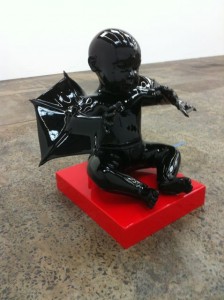 If you were on Cockatoo Island for the Biennale of Sydney in 2010, you would have seen the extraordinary, gleaming piece of video art by the Russian artist collective known as AES+F. Titled The Feast of Trimalchio, the video was projected onto a 360-degree circular screen and was mesmerising and seductive, marked by some of the grand excesses of a 1950s Hollywood extravaganza about the Bible, complete with Charlton Heston in sandals and leather cuirass.
If you were on Cockatoo Island for the Biennale of Sydney in 2010, you would have seen the extraordinary, gleaming piece of video art by the Russian artist collective known as AES+F. Titled The Feast of Trimalchio, the video was projected onto a 360-degree circular screen and was mesmerising and seductive, marked by some of the grand excesses of a 1950s Hollywood extravaganza about the Bible, complete with Charlton Heston in sandals and leather cuirass.
Last week I interviewed Tatiana Arzamasova, the A from AES+F, at Anna Schwartz Gallery in Carriageworks, Sydney. Arzamasova was in Sydney to represent the rest of AES+F at the opening of their latest exhibition, titled Angels-Demons. I was doing a story for the Daily Telegraph, and you can read it here.
Angels-Demons comprises seven black, fibreglass statues resting on individual bright red plinths. Each statue depicts a huge baby either standing, sitting or crawling on all fours. The first thing that hits you is their gorgeous patina, a dazzlingly reflective surface which really does look quite devilish. Each baby sports a demonic tail, and several have nascent, webbed wings a bit like those of a fruit bat.
While these bouncing babies stand around two metres tall, they are based on AES+F’s original babies which were six metres tall. They premiered in 2009 in Lille3000, the French arts festival, where they were located outside.
Last week, Tatiana Arzamasova fussed over the seven babies at Anna Schwartz, getting their location within the gallery space just to her satisfaction. This involved much discussion with gallery owner Schwartz, and the going out and coming back in of both women in order to see each new placement with a fresh eye before deciding whether the arrangement was satisfactory.
Arzamasova directed a very patient young man with a hand-operated forklift device, who was shuttling the sculptures around on wooden palettes.
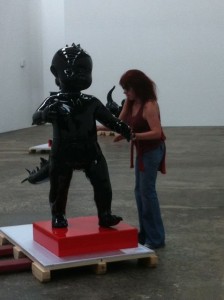 Once she was happy with the lay-out of the babies, Arzamasova and I went outside the gallery so she could smoke her ultra-thin Russian cigarettes while we talked. I mentioned that the babies and their anachronistically devilish features reminded me of the film Rosemary’s Baby, where Mia Farrow’s first-born is fathered by the Devil, and also the film Gremlins, where cute little furry critters turn out to be really very evil.
Once she was happy with the lay-out of the babies, Arzamasova and I went outside the gallery so she could smoke her ultra-thin Russian cigarettes while we talked. I mentioned that the babies and their anachronistically devilish features reminded me of the film Rosemary’s Baby, where Mia Farrow’s first-born is fathered by the Devil, and also the film Gremlins, where cute little furry critters turn out to be really very evil.
Arzamasova agreed.
“We love to play with cinema images and it has a lot of links to babies by Stanley Kubrik,” she said.
“First of all we created the concept that it will be not dangerous and not demons; that it will be babies without any European roots, without gender and with both symbols of goodness like wings and with the tails, in just one [body].
“They will grow up and the nature will take over. Because it’s really difficult to recognise the goodness and the evil especially when it’s symbols as image of a baby. It’s much more mystical and unpredictable than just an adult person.”
I asked whether she and the others in AES+F were standing by, wondering whether the world’s future were to be hopeful or bleak?
Arzamasova shrugs: “Like everybody,” she says.
“We just talk about the future in general. When we did the concept and first drawing, we talked about the idea of childish apocalypse.”
AES+F comprises Arzamasova and her husband Lev Evzovich, plus Evgeny Svyatsky and Vladimir Fridkes. The four artists, whose backgrounds encompass architecture and fashion photography among other disciplines, all gained a traditional grounding in the foundations of art in the Soviet era.
“Denis Diderot said, ‘don’t believe the architect who can’t draw,” Arzamasova said with a deep chuckle.
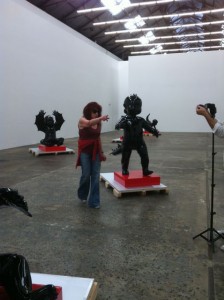 The way Arzamasova described it, the four work together every day in their shared studio in Moscow. Yes, they sometimes disagree on an artistic decision. But they work their way through their differences in order to collaborate in a very close way.
The way Arzamasova described it, the four work together every day in their shared studio in Moscow. Yes, they sometimes disagree on an artistic decision. But they work their way through their differences in order to collaborate in a very close way.
“We work as one artist with four bodies,” she said.
What about when they disagree? “Normally it’s a standard scandal. It’s true,” Arzamasova said, laughing. “And if you want to explain your position you should be tolerated. Normally sometimes we are really tough to each other, but it’s never going to destroy the group.”
Art Gallery of South Australia director Nick Mitzevich, who said he is “obsessed” with AES+F and has commissioned work by them, has been to their Moscow studio.
“It’s quite modest,” Mitzevich said. “It’s in one of those big high-rise buildings way out in the suburbs. It’s like the Communist state’s art studios. It’s full of lots of creative people. You catch this rickety lift up to their floor and it’s this very modest studio space. Their studio is full of Mac computers with huge screens. Lots of print outs and digital images. Tatiana and Lev’s family works on the production. There’s a sense of family that supports them. Their son supervises all their production.”
The studio is near the Vorobyovy Hills, the site of the last flight of the devil from Moscow in Mikhael Bulgakov’s novel, The Master and Margarita, Arzamasova said.
And speaking of the devil, the babies’ tails are a sign of our link to nature, Arzamasova said. “It’s also a sign of embryo development, because in development we are jumping all steps — to be fish, to be snake.”
Mitzevich said the AGSA purchased AES+F’s film work, Allegoria Sacra, last year. The work is currently on view at the gallery.
“I viewed the work half finished about a year and a half ago in Venice,” Mitzevich said. “We committed to buying the work and it made it possible for them to finish the work. These undertakings [of AES+F] are massive productions. This work was a really important work for us. It covers so many bases which our collection reveals. So many wonderful references to the chaos of the world we live in. And the work references the history of art and European religious art. We are very strong in both. It continues their obsession with mining the history of art and imagery. It’s a very important addition to the contemporary collection.”
A demon-baby appears in Allegoria Sacra, very similar to the ones now on view at Anna Schwartz. “They [AES+F] have worked in this form before,” Mitzevich said. “They continually go back to similar themes but they extract new ways of looking at things. This work [Angels-Demons] continues their complete irony and wit in their work. It’s a critique of the world we live in and it’s sometimes a bleak future, but it’s the irony and wit that gives it such a great currency and seduction.
“They are the first to admit that seducing the audience is something that’s important to them. They want to communicate their message to a wide audience.”
Elizabeth Fortescue, February 18, 2013
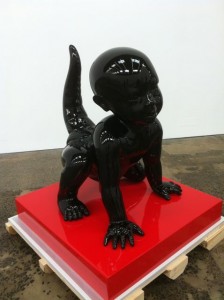
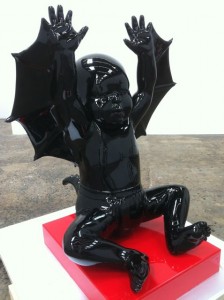
| Print article | This entry was posted by Elizabeth Fortescue on February 18, 2013 at 11:09 pm, and is filed under News. Follow any responses to this post through RSS 2.0. You can leave a response or trackback from your own site. |
